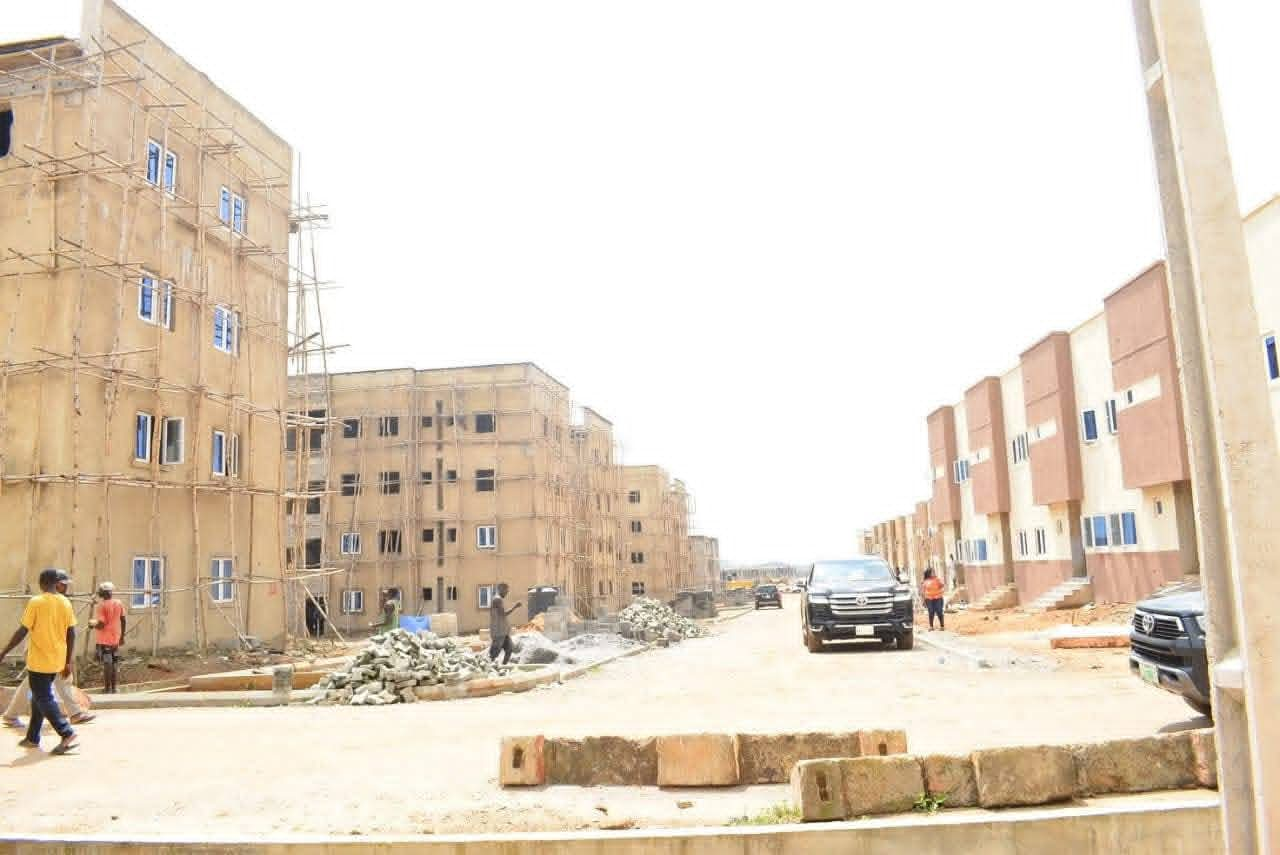Nigeria’s property market, squeezed by high inflation, limited mortgage access, and rising housing supply, is showing clear signs of shifting from a seller’s to a buyer’s market. The strongest indicators of this transition are emerging in the high-end residential and commercial segments, where unsold units and vacancy rates continue to climb, CHINEDUM UWAEGBULAM reports.
After years of runaway prices and brisk sales, Nigeria’s property market may be showing signs of fatigue as recent data point to a gradual cooling, with a rise in listings, longer selling periods and softening demand in the upper end of the market, even as prices remain elevated in major urban centres.
Analysts said that while the fundamentals still favour sellers, emerging indicators suggest the balance of power between buyers and sellers could be beginning to narrow.
Stock levels on the rise
ACCORDING to market data from Nigeria Property Centre, Lagos alone had about 47,000 houses listed for sale in September 2025, one of the highest in recent years. The increase reflects a buildup of unsold inventory as economic conditions weigh on both developers and potential homeowners.
A study published on academia.edu found that the average time on market for residential properties in Lagos stands at about 145 days, roughly four and a half months, a period longer than is typical for a market dominated by sellers.
Vacancy data also reveal a mixed picture. Residential vacancy rates in Lagos average around 11 per cent, while in the commercial segment, Grade A and B office spaces record vacancies between 12 and 36 per cent, according to Estate Intel and Naija Houses. In Ikoyi and Victoria Island, prime office vacancies have stabilised between 14 and 16 per cent, suggesting that demand has softened compared with the pre-pandemic boom.
Statistics from Knight Frank Nigeria’s Lagos Market Update revealed that occupancy rates in Grade A properties have increased from 65 per cent to 73 per cent, indicating a significant rise in the absorption of these premium office spaces. However, despite this rise in occupancy, average rental rates for Grade A office spaces in Ikoyi dropped by 3.5 per cent year-on-year, decreasing from $57 to $55 per square metre per month.
Luxury slowdown, affordable resilience
THE cooling appears more visible in the luxury and high-end markets, where supply outpaces immediate demand. Reports by Naija Houses indicate a noticeable dip in demand for premium apartments in Ikoyi, Banana Island and Abuja’s Maitama districts, with some developers offering incentives or flexible payment options to close deals.
However, the mass residential segment, middle-income and affordable housing continue to experience pressure from Nigeria’s staggering 21-million-unit housing deficit. The shortage of liveable, affordable homes keeps demand robust, particularly in Lagos, Ogun, and parts of Abuja, where population growth and urbanisation remain strong drivers.
Prices defy gravity
DESPITE signs of market fatigue, prices remain on an upward trajectory in several states. Data from BuyLetLive’s 2024 Nigeria Property Price Index show residential prices in Lagos rising by about 39.46 per cent, while neighbouring Ogun recorded 30.48 per cent growth.
In addition, rental yields in Lagos hover around 5.5 per cent, according to a July 2025 AllAfrica report, underscoring continued investor interest in the property sector as a hedge against inflation and currency devaluation.
Economic headwinds weigh on sentiments
RISING construction costs, double-digit inflation and currency depreciation have combined to dampen both developer confidence and buyer affordability. Materials such as cement, iron rods and paint have surged in price over the past year, while mortgage rates remain high, making financing difficult for middle-income buyers.
The Housing Development Advocacy Network recently warned that the industry faces “tough times” due to falling sales volumes and increasing project delays, even as many developers attempt to re-price projects or scale down new launches.
Not yet a buyer’s market
EXPERTS agreed that Nigeria has not yet entered a full-blown buyer’s market, but the gap between seller dominance and buyer opportunity is narrowing. The strongest signs of a shift are visible in high-end residential and commercial properties, where unsold units and vacancies are mounting.
Still, the chronic housing shortage and persistent population growth ensure that demand remains higher than supply in most segments. Affordable-housing developers, in particular, continue to report waiting lists for units priced below N30 million.
Market watchers appear divided on the current status of Nigeria’s property market. While some analysts agree that the sector is gradually tilting towards a buyer’s market, others remain cautious, describing the trend as a mild correction rather than a full transition.
They believe the direction of the real estate market over the next year will hinge on macroeconomic stability, access to mortgage finance, and developers’ ability to clear rising inventories of unsold homes.
Analysts describe the present landscape as a market that is cooling but not collapsing, correcting but not crashing. Whether this adjustment evolves into a genuine buyer’s market remains uncertain. However, for the first time in years, buyers now appear to have more room to negotiate prices.
The Second Vice President, Nigerian Institution of Estate Surveyors and Valuers (NIESV), Dr Emmanuel Mark, told The Guardian that Nigeria’s property market is indeed shifting from a seller’s market to a buyer’s market.
“This change is driven by several factors, including an increase in rental properties, which gives tenants more negotiating power. The number of real estate developers and agents has also grown by 10 per cent and 12 per cent respectively, indicating a rising supply of properties that favours buyers,” he said.
Despite a housing deficit estimated at over 20 million units, Mark noted that demand remains particularly strong in the affordable housing segment.
“Buyers are becoming more discerning, prioritising factors like location, security, and modern amenities. The rise of gated communities and smart homes reflects this shift in preferences,” he added.
He explained that technology is reshaping the market by improving access to data and increasing transparency. “Technology is providing buyers with more options and better access to information, enabling them to make informed decisions. The market is changing and buyers are benefiting from the shift,” he said.
However, Mark cautioned that the market faces serious headwinds such as rising construction costs, inflation, and currency depreciation. “High prices and economic uncertainty have dampened demand, particularly for affordable homes. Supply chain disruptions and the weak naira have further compounded the problem, squeezing both buyers and sellers. Buyers are struggling to afford homes, while developers are contending with thinner margins and financing hurdles,” he explained.
According to him, Nigeria’s luxury and middle-income property segments are slowing due to high interest rates and escalating development costs. “The luxury segment has seen reduced demand from high-net-worth individuals, while middle-income buyers face affordability constraints. Affordable housing remains a priority, and government initiatives aimed at improving accessibility could drive recovery,” Mark added.
He observed that longer listing periods, tougher negotiations, and flexible pricing are now more common. “One indicator that Nigeria’s property market has tilted in favour of buyers is increased inventory, price reductions, and wider negotiation margins. These signal a shift in dynamics and give buyers more control,” he said.
For the former Chairman of NIESV Lagos Branch, Mr Stephen Jagun, early signs of a transition are becoming evident. “While the market has traditionally favoured sellers due to the massive housing deficit and persistent price growth, we are beginning to see buyer hesitation, price resistance, and slower deal closures, especially outside prime locations,” he noted.
Jagun explained that economic headwinds have significantly raised project costs, pushing up property prices across major urban centres. “Inflation, now above 28 per cent and naira devaluation have weakened purchasing power, making home ownership less attainable. Developers are passing these costs to buyers, but demand is softening, particularly among middle-income earners who depend on financing,” he said.
According to him, the middle-income market segment is under the most pressure. “Rising costs, expensive loans, and limited access to mortgages are shrinking the pool of eligible buyers. Many in this bracket are deferring purchases or opting for rentals instead,” he said.
He added that while luxury housing remains somewhat resilient, driven by wealthy Nigerians and diaspora investors, affordable housing continues to suffer from undersupply and poor alignment with genuine affordability thresholds.
Jagun observed that properties in the mid-to-upper price bands are spending more time on the market. “Sellers are becoming more flexible. Modest discounts off asking prices are becoming common, and developers now offer flexible payment plans more frequently to sustain buyer interest,” he noted.
He stressed that confirmation of a full-fledged buyer’s market would require sustained price declines across key segments and locations, a significant rise in listing inventories, longer selling periods, and lower transaction volumes despite higher supply.
“Until those conditions persist for several quarters, what we are seeing is a softening market, one that is gradually rebalancing after years of seller dominance,” Jagun added.






